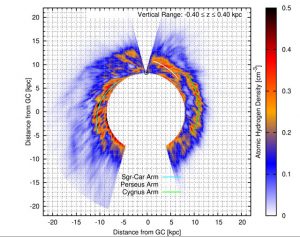
By
Tyler Foster and Tyler Wilson
December 2017
Print Version
What you need to know
The Milky Way galaxy is our home galaxy; a flattened disc of some 200 billion stars and gas that is arranged in a spiral pattern. As our own star the Sun is embedded in the disc, the only view we have is that of an insider: a thick band of diffuse milky starlight that encircles us around the sky. Making a birds-eye “map” or plan-view of the Milky Way is as daunting a task as is being asked to map an entire forest while you are tied to a single tree inside it. We are using a mathematical approach and desktop-computational power to transform the newest radio telescope observations of the sky into a 3-D map of the Milky Way. Our preliminary computed maps are a large improvement over past attempts, with clearer and sharper definition of the spiral pattern.
Why this research is important
Having a map of the Milky Way is a fundamental necessity to embarking on nearly any study of our galaxy. Yet, today astronomers still do not agree on even the most basic features of the Milky Way. How many spiral arms are there? Where is the Sun’s place within the pattern, and where was it when it formed billions of years ago? How does the pattern change above or below the disc? How far from the Galactic centre does the pattern end?
How this research was conducted
Radio telescope observations of hydrogen gas and its distribution in the sky tell us three dimensions of information.
The first two are position coordinates on the sky of a patch of gas (two coordinates ℓ,b analogous to longitude and latitude). The third is its space velocity v with respect to the Earth (in kilometres per second). This speed arises because the gas is in orbit of the Galactic centre (like the Sun is too), but also because of random motions in the gas like turbulence. Unfortunately, ℓ ,b,v are not the three dimensions that directly map the gas’ distribution: we need x,y,z positions for that. However, they are related to each other mathematically through what is known as the fundamental equation of galactic structure analysis. Turning (ℓ,b,v) into (x,y,z) has been the confounding subject of galactic structure studies since the first radio observations of hydrogen were done in the early 1950’s. The difficulty in part is because this equation requires us to know a priori how the galaxy rotates, and where the Sun is in the Galaxy, to name a few things before it can be solved. If we neglect turbulence and adopt an educated guess of how our Galaxy might be rotating (based on how other spiral galaxies in the universe are observed to rotate), we can calculate a set of geometric x,y,z coordinates for each ℓ,b,v location. This idea is not new but has been tried only a handful of times since the 1950’s. Results have always been blurry, ill-defined 2D maps barely hinting at a spiral structure. What makes our modern approach unique is that in addition to clever computational techniques, we also use new very recent high-resolution observations of the hydrogen distribution across the sky, made with the 100-metre Effelsberg radio telescope near Bonn, Germany. We also produce a 3-dimensional map of the Milky Way in all three coordinates (x,y,z), rather than a 2D picture in (x,y). We do this by computing maps at various height ranges (z-slices), like slicing up a pineapple from bottom to top.
What the researchers found
Our maps show the clearest view of the Milky Way today computed by this technique, and certainly will be a significant contribution to the knowledge of Milky Way structure. One of our preliminary z-slices is presented in the figure. The Sun is marked with a “circle-dot”. The region inside the Sun’s orbit (the “hole” in the pineapple analogy) is not calculated because in this region the solutions to the equation are two different sets of possible (x,y,z) coordinates, and there is no way of telling how much gas is found at each position. Our maps confirm that the Milky Way is a 4-armed spiral galaxy and that the Sun is located not within a spiral arm but in an inter-arm region. We can identify and locate the four spiral arms that are colloquially known (and whose locations were poorly determined). Fitting of logarithmic spiral segments in each z-slice shows that the winding angle of each spiral arm stays remarkably constant around the centre, but changes systematically with z-height below and above the middle of the disk. This strange “spiral helix” structure is an exciting and unexpected result that we are working to confirm. We also look forward to trying some more clever computational techniques we have dreamt up to fill in the “hole” in the Inner Galaxy!

How this research can be used
Having an accurate 3-D map of the Milky Way is pre-requisite to enable future studies by astronomers of its structure, formation, evolution, and the “place” our galaxy occupies within the galactic zoo in the universe. Current theories show that spiral structure and a galaxy’s rotational dynamics are very much linked together, and having a clearer view of the pattern in the Milky Way will constrain theories of galactic dynamics and even the amount and distribution of dark matter surrounding our galaxy. Finally, for the armchair astronomer; while our maps will not cure the common cold, we may be getting closer to the day when actual pictures of our own galaxy are shown in coffee-table astronomy books rather than paintings. Chicken soup for the imagination!
Acknowledgements
Foster would like to acknowledge BURC, BUSU Work-Study, and the federal government’s Canada Summer Jobs program for their support of this research.
About the Researchers
Keywords
- galaxy
- hydrogen gas
- map
- Milky Way
- radio astronomy
- spiral
Editor: Christiane Ramsey
Read more BU Research
Research at Brandon University follows comprehensive policies designed to safeguard ethics, to ensure academic integrity, to protect human and animal welfare and to prevent conflicts of interest.


